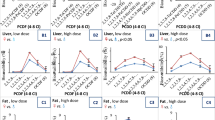Abstract
Groups of male Sprague-Dawley rats were administered orally the following chlorinated dibenzo-p-dioxins (CDDs) in corn oil/acetone (95/5; v/v): 30–60 μg/kg 2,3,7,8-tetrachlorodibenzo-dioxin (tetra-CDD), 160–270 μg/kg 1,2,3,7,8-pentachlorodibenzo-p-dioxins (penta-CDD), 630–1249 μg/kg 1,2,3,4,7,8-hexachlorodibenzo-p-dioxin (hexa-CDD) and 5000–8000 μg/kg 1,2,3,4,6,7,8-heptachlorodibenzo-p-dioxin (hepta-CDD) or a mixture of the four homologues such that each was present in the mixture at one quarter of its dose as a single compound. Animals were killed at 2 and 8 days after dosing. Livers were immediately removed, and aliquots frozen in liquid nitrogen. Storage occurred at −80°C until further use. About 0.2 g of each lyophilized rat liver was extracted, the extract purified by column chromatography and analyzed by GC/MS for CDD content. Results obtained suggest that the absorption of CDDs after oral administration decreases in the order of tetra-CDD≥penta-CDD>hexa-CDD>hepta-CDD, indicating that the dose was an incomplete surrogate of exposure in parts I–III of this publication series (Stahl et al. 1992; Weber et al. 1992a,b). Moreover, data also support the notion that the pharmacokinetics of CDD mixtures at high doses are somewhat different from those expected based on single compound exposures. Our findings suggest that the intrinsic relative potency in terms of toxic equivalents (TEQ) of the higher chlorinated homologues is slightly greater (about a factor of 2) than suggested by Stahl et al. (1992), because of reduced absorption, whereas the contribution to total potency of the lower chlorinated homologues in mixtures is slightly higher (about a factor of 2) because of increased relative liver concentrations. This later finding appears to be due to altered pharmacokinetics of mixtures of CDDs, probably originating in changes of partial solubility of the lower chlorinated homologues in fat under conditions of near saturation.
Similar content being viewed by others
References
Abraham K, Krowke R, Neubert D (1988) Pharmacokinetics and biological activity of 2,3,7,8-tetrachlorodibenzo-p-dioxin: 1. Dose-dependent tissue distribution and induction of hepatic ethoxyresornfin-O-deethylase in rats following a single injection. Arch Toxicol 62: 359–368
Birnbaum LS, Couture LA (1988) Disposition of octachlorodibenzo-p-dioxin (OCDD) in male rats. Toxicol Appl Pharmacol 93: 22–30
Couture LA, Elwell MR, Birnbaum LS (1988) Dioxin-like effect observed in male rats following exposure to octachlorodibenzo-p-dioxin (OCDD) during a 13-week study. Toxicol Appl Pharmacol 93: 31–46
Kutz FW, Barnes DG, Bretthauer EW, Bottimore DP, Greim H (1990) The international toxicity equivalency factor (I-TEF) method for estimating risk associated with exposures to complex mixtures of ioxins and related compounds. Toxicol Eviron Chem 26: 99–109
Rose JQ, Ramsey JC, Wentzler TH, Hummel RA, Gehring PJ (1976) The fate of 2,3,7,8-tetrachlorodibenzo-p-dioxin following single and repeated oral doses to the rat. Toxicol Appl Pharmacol 36: 209–266
Stahl BU, Kettrup A, Rozman KK (1992) Comparative toxicity of four chlorinated dibenzo-p-dioxins (CDDs) and their mixture. Part I: acute toxicity and toxic equivalency factors (TEFs). Arch Toxicol 66: 471–477
Viluksela M, Stahl BU, Rozman KK (1994) Subchronic (13-week) toxicity of heptachlorodibenzo-p-dioxin in male Sprague-Dawley rats. Chemosphere 29: 2381–2393
Weber LWD, Lebofsky M, Stahl BU, Rozman KK (1992a) Comparative toxicity of four chlorinated dibenzo-p-dioxin (CDDs) and their mixture. Part II: structure-activity relationships with inhibition of phosphoenolpyruvate carboxykinase, pyruvate carboxylase, and γ-glutamyl transpeptidase activities. Arch Toxicol 66: 478–483
Weber LWD, Lebofsky M, Stahl BU, Rozman KK (1992b) Comparative toxicity of four chlorined dibenzo-p-dioxins (CDDs) and their mixture. Part III: structure-activity relationship with increased plasma tryptophan levels, but no relationship to hepatic ethoxyresorufin-O-deethylase activity. Arch Toxicol 66: 484–488
Weber LWD, Ernst SW, Stahl BU, Rozman KK (1993) Tissue distribution and toxicokinetics of 2,3,7,8-tetrachlorodibenzo-p-dioxins in rats after intravenous infection. Fundam Appl Toxicol 21: 523–534
Author information
Authors and Affiliations
Rights and permissions
About this article
Cite this article
Rozman, K.K., Stahl, B.U., Kerecsen, L. et al. Comparative toxicity of four chlorinated dibenzo-p-dioxins (CDDs) and their mixture. Arch Toxicol 69, 547–551 (1995). https://doi.org/10.1007/s002040050210
Received:
Accepted:
Issue Date:
DOI: https://doi.org/10.1007/s002040050210




